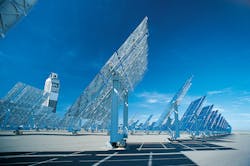Nikola Tesla (Westinghouse) and Thomas Edison (GE) battled in the early twentieth century on what type of electricity current would prevail, alternating (AC) or direct (DC). AC won the 20th century but ABB today announced a breakthrough in the ability to interrupt DC transmission. It says solving a 100-year-old electrical engineering puzzle and paving the way for more DC power applications.
After years of research, ABB has developed the world’s first circuit breaker for high-voltage direct current (HVDC). It combines very fast mechanics with power electronics, and will be capable of ‘interrupting’ power flows equivalent to the output of a large power station within 5 milliseconds—that is thirty times faster than the blink of a human eye.
ABB is pointing to the implementation of DC power grids in remote areas, where AC grids have not been built. The company points to remote areas, such as hydropower plants in mountains far from urban centers, offshore wind farms or rooftop solar panels. DC is the only technology that allows power to be transmitted economically over very long distances, and DC is the type of power produced by photovoltaic panels.
And, ABB is not looking to displace DC grids either. The company says that the new development will help improve grid reliability and enhance the capability of existing AC networks. ABB is in discussions with power utilities to identify pilot projects for the new development.
“ABB has written a new chapter in the history of electrical engineering. This historical breakthrough will make it possible to build the grid of the future. Overlay DC grids will be able to interconnect countries and continents, balance loads and reinforce the existing AC transmission networks," says Joe Hogan, CEO of ABB.
The Hybrid HVDC breaker development has been a flagship research project for ABB, which invests over $1 billion annually in R&D activities. ABB's R&D leveraged in-house manufacturing capability for power semiconductors, converters and high voltage cables (key components of HVDC systems) for this new development.
HVDC technology is needed to facilitate the long distance transfer of power from hydropower plants, the integration of offshore wind power, the development of solar projects and the interconnection of different power networks. ABB pioneered HVDC nearly 60 years ago and continues to be a technology driver and market leader with many innovations and developments. With over 70 HVDC projects, ABB accounts for around half the global installed base, representing an installed capacity of more than 60,000 megawatts (MW).
Deployment of HVDC has led to an increasing number of point-to-point connections in different parts of the world. The logical next step is to connect the lines and optimize the network. ABB is already working on the construction of multi-terminal systems and the latest DC breaker innovation is a major step in the evolution of HVDC grids. In parallel to the new hybrid breaker development, ABB has an established HVDC grid simulation center developing solutions for future DC overlay grid operations.
About the Author
Grant Gerke
Digital Managing Editor

Leaders relevant to this article:
